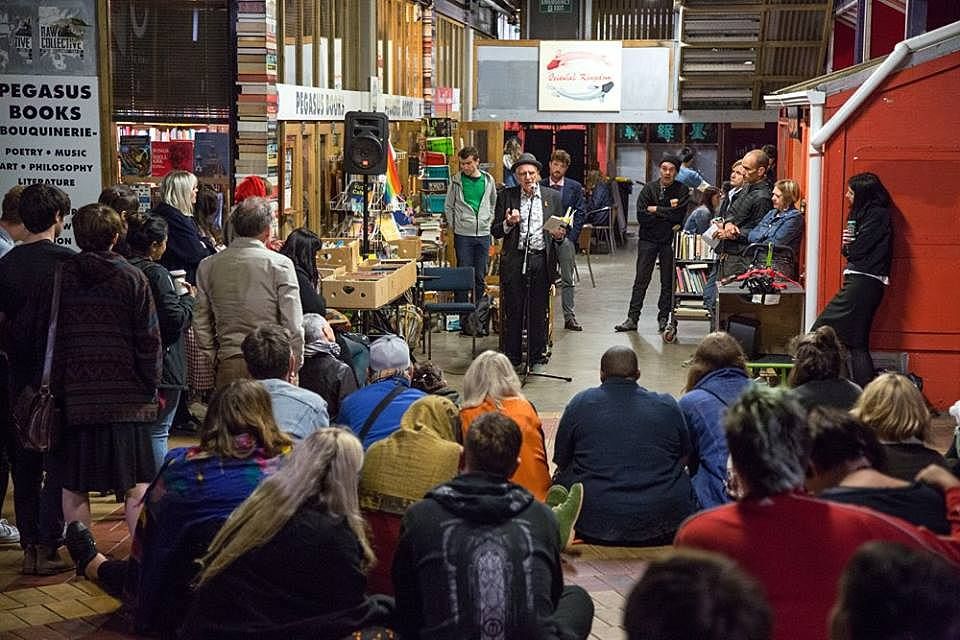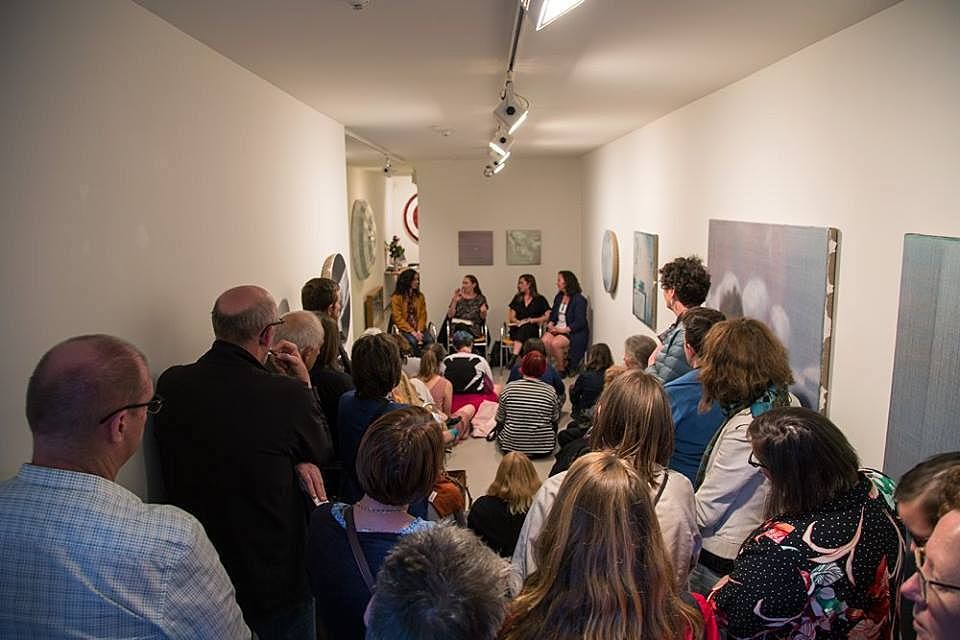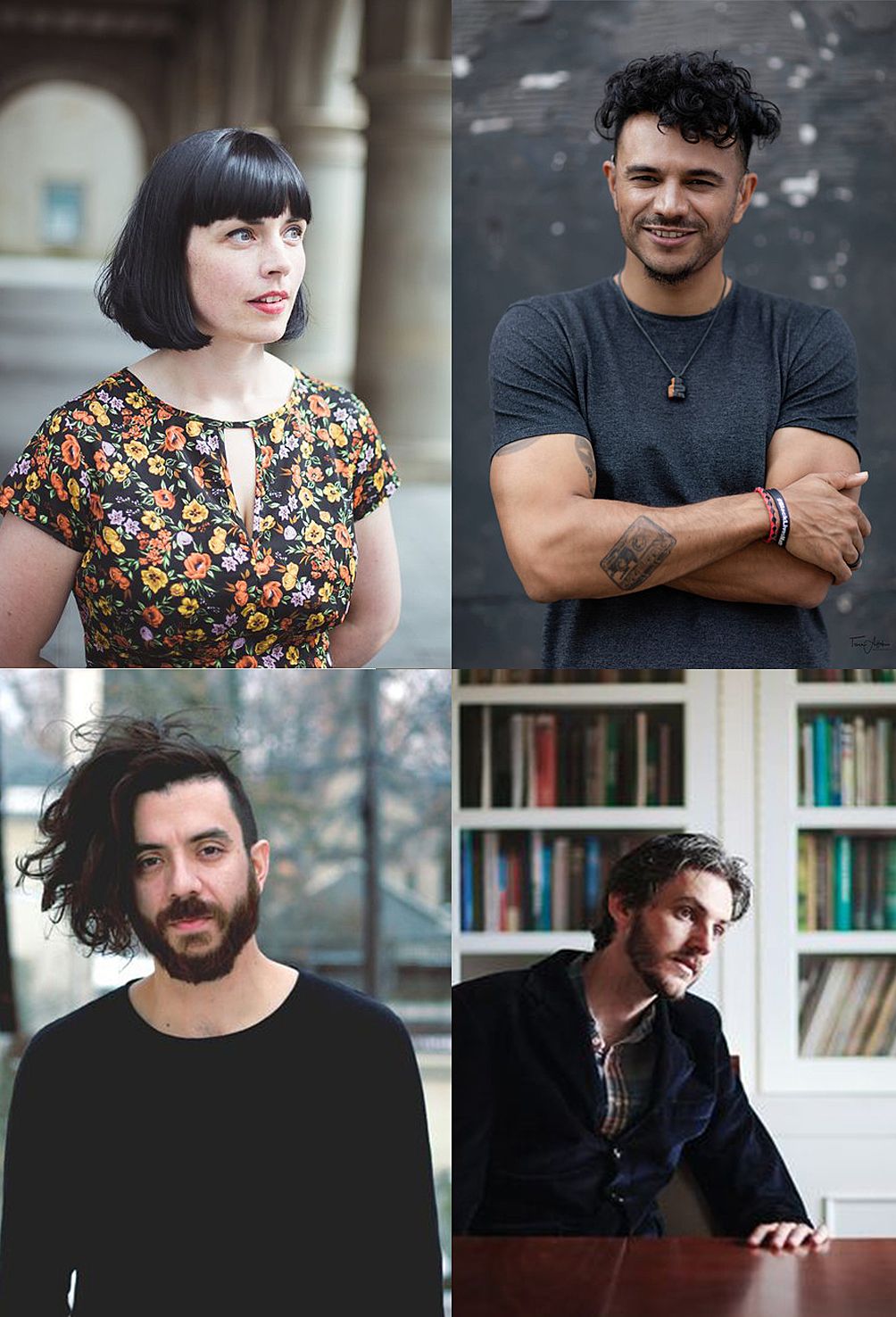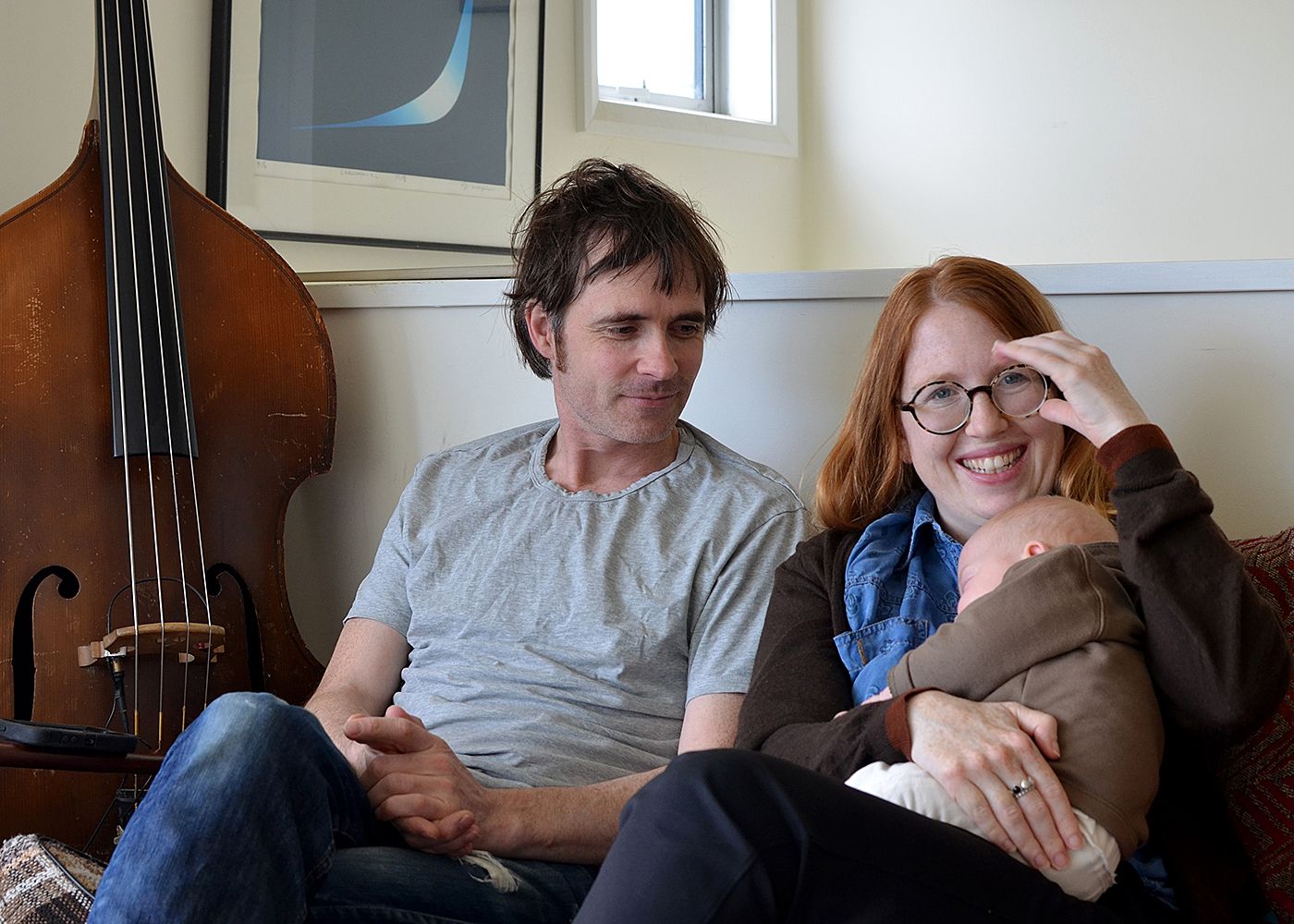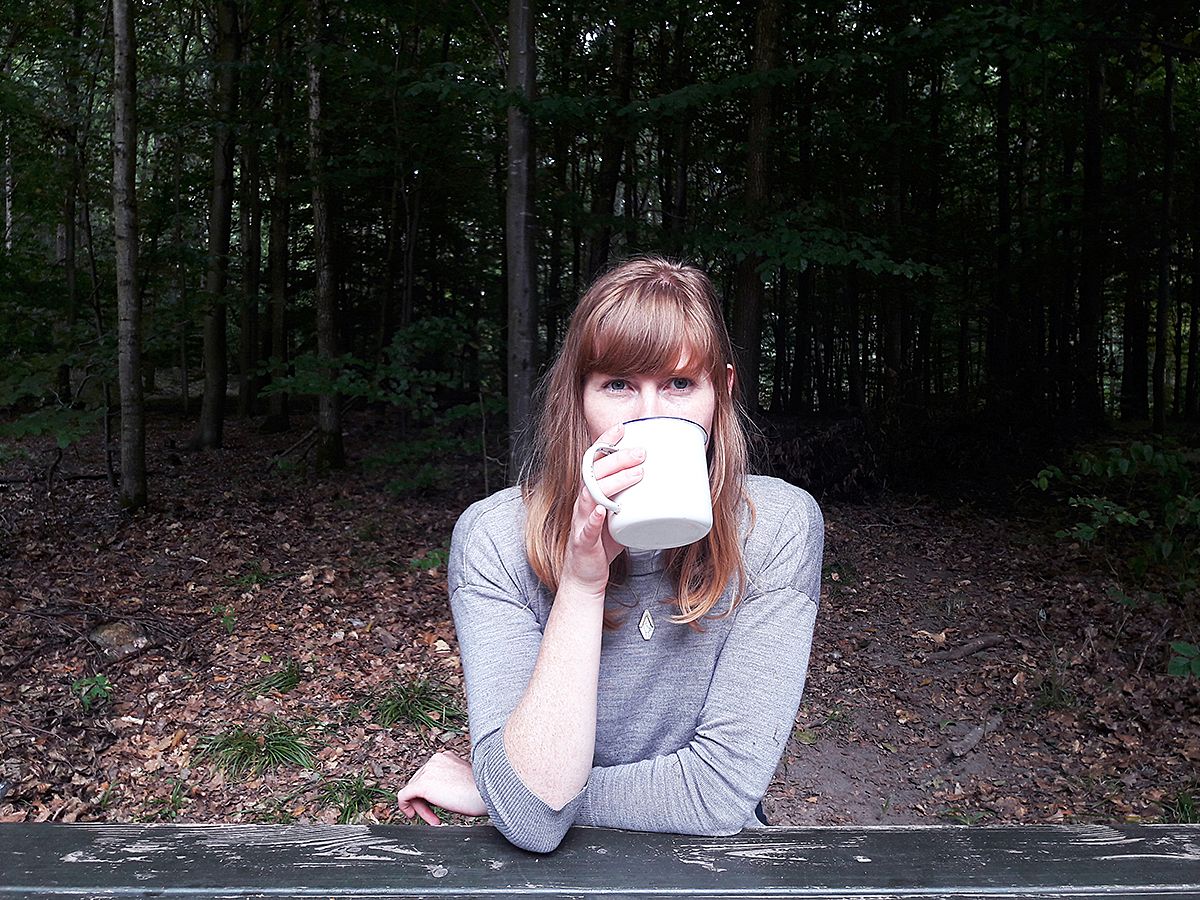Pirate and Queen: An Interview with Claire Mabey and Andrew Laking
Hannah Newport-Watson talks to the duo behind LitCrawl and Lōemis about what it takes to create independent literary and arts festivals in Wellington.
Hannah Newport-Watson talks to the duo behind LitCrawl and Lōemis about what it takes to create independent literary and arts festivals in Wellington.
Every year, Wellingtonians crowd into local bookshops, bars, businesses and alleyways to hear writers read, perform and debate. In these sometimes unlikely venues, every nook and cranny is stuffed with people, excited and breathless from marching from their previous session to claim a spot at the next.
Since it started five years ago, LitCrawl has gone from strength to strength. Claire and Andy introduced a LitCrawl Extended Series, which features a range of ticketed events in the days or weeks surrounding the main sessions. This year’s festival programme sees the largest Extended Series yet, plus a brilliant new initiative called Micro Residences, run in partnership with Starling journal, in which six young writers are hosted in central Wellington art galleries for the weekend, just to write.
LitCrawl is now an essential feature in the literary landscape of Wellington. Meanwhile, Claire and Andy have been at work on a variety of other projects, such as Lōemis, a mid-winter multi-arts festival, which made quite an impression this year by culminating with the spectacular burning of a giant winged effigy in Whairepo Lagoon.
Claire and Andy do much of this work from their rather wonderful, treehouse-like home in Southgate, which they share with baby Charlie. I caught up with them amidst books, musical instruments and baby paraphernalia to talk about producing literary and arts festivals in Wellington.
Hannah Newport-Watson: How did the idea for LitCrawl Wellington germinate?
Claire Mabey: What really started it was Andy’s enthusiasm for doing our own festival. Andy was back from overseas. I was working for the New Zealand Festival for Writers Week, and when that contract ended I was ready to go back overseas for about six months. It was in quite a short little period of time when we were hanging out quite a lot.
Andy was really confident, whereas I’d never thought about doing it myself. But then the more we talked about it, the more excited I got. Then I had a conversation with a guy who was visiting from Iowa, teaching at the IIML. He said to me, “Wellington would be perfect for an event like a lit crawl.”
I went overseas to lots of different festivals. I never went to a lit crawl, but I ended up Skyping with the guy who ran the Iowa one. He was like, “Maybe just give it a try.” I went to one particular festival in Dublin called Words on the Street, which features European writers, all in one square. It was really exciting and energetic. It made me realise how perfect Wellington was for that format – the compact walking festival.
So we asked people if they were interested in being part of it. Lots of people were excited by the idea. The first programme actually came together relatively easily. We did it on a real shoestring. I didn’t think anyone would come. It just happened to really suit Wellington and the time.
HNW: Was it on a shoestring because it was difficult to get funding when you hadn’t already proved you could do it?
CM: I think we didn’t even bother with CNZ at the time. Because we’d both come from frugal arts backgrounds, we did manage to pull off what we needed with hardly any money. We were really well supported by New Zealand Festival – they gave us an office. I’m pretty sure we maxed out our welcome with the photocopier. Early partnerships made it possible. Vic Books was really supportive right from the beginning, which surprised me because it was such an untested thing. And the Wellington Community Trust, I think one of our first grants was from them. And the Wellington City Council. For LitCrawl, everything we do is about the partnerships, in all ways. Partnerships with publishers, partnerships with writers, partnerships with venues.
The venues are such a core part of it. Wellington is as much a character in this whole festival as the events and the writers are. People like Terry from the Ferret Bookshop, who’s been there since the beginning. Chrissy at Hunters and Collectors. Really amazing people who have been running businesses and sticking to their guns for a really long time. They’re very generous. I was surprised at how willing venues were to do LitCrawl. I imagined that it would be seen as a major interruption, but it’s not seen like that.
Wellington is as much a character in this whole festival as the events and the writers are.
Andrew Laking: Especially because more than half the venues are not normally venues. Which is one of the challenges production-wise. I remember one year, at one venue, it had kind of slipped the owner’s mind and he had gone off to the pub. We couldn’t get hold of him and we were trying to move it down the road… but then he turned up.
CM: I think he was also surprised at how many people turned up. I don’t think he thought anyone would come. That was funny.
The total budget in the first year was something teeny. Our marketing budget was something ridiculous like a hundred dollars. We did it voluntarily as well. After that, when we were able to prove that it was a successful model, it was easier to get funding.
HNW: How did you record what you needed to say, “We had a successful first season”?
CM: I think that’s one of the most difficult and irritating things about the arts sometimes – having to prove why you’re doing what you’re doing. We had great photographers for that very first festival, and the photos all show these beautifully crammed rooms.
Probably the strongest support and proof came from writers themselves, who were quite amazed at the crowds and wrote us great letters of support. Bill Manhire wrote a letter about how it felt like the early days of Landfall and Sport. It was really nice, because obviously the writers felt really good about seeing different crowds, energetic crowds. It happened a lot in the first LitCrawl that people couldn’t get into their first choice of venue. I think that story, via word of mouth, took on a life of its own.
HNW: It seems to me there’s that real bittersweet aspect to selling out or maxing out your venues, which are so small and intimate. There’s a lot of fomo with LitCrawl! You’re constantly making hard decisions between things that you want to see that are on at the same time, but also knowing that you might turn up and just not get in. It’s so nice for a writer to be ‘sold out’ but then you don’t want too many disappointed people. How do you think that balance works?
CM: I think that risk factor is essential to the success of the event, because it’s what drives people to offer the energy that it needs. You need to be quite fast; you need to be a little bit ruthless and pushy and enthusiastic about it.
But it really freaked me out in the second or third LitCrawl, when I was at Arty Bees for the science session. I knew it would be popular because there were amazing people reading at it, but it was crazy. There were these automatic sliding doors and I was getting really worried because they were trying to close on people and it was actually quite horrible at the back. I realised that actually this might spill into a negative experience for some people, which I didn’t want. So that’s when we increased the size. We went from 15 to 18 or 19 sessions, and then 24.
HNW: I did notice that you’ve mixed in some slightly larger venues, like City Gallery and Wellington City Library. Was that a deliberate choice to have an option where you can always accommodate people?
AL: Yeah. We’ve structured the venues so that we know there’s a certain capacity that we can handle at each phase, and we’ve geographically situated the venues near each other so that if you can’t get into one, there should be other options really close by.
CM: A lot of people were asking, “Why don’t you just move them to really big venues?” But I think that would be a totally different thing.
AL: I like that you get randoms who get swept up in it as well.
CM: The football fans last year were awesome. They were easy to spot because they all had their full white onesies on. They had no idea what they were in, it was so good.
HNW: It’s really cool that you’ve now got more visual arts venues involved, for instance through the residencies.
CM: My conundrum in life has been an inability to separate visual arts and literature. That’s what I studied – English literature and art history, and I sometimes find that tendency in education to compartmentalise things to be really confusing. That’s why I really enjoy working with City Gallery, because we’re able to programme writers to respond to the exhibitions, like the Patrick Pound one that we just did. So those relationships with the galleries are really important and exciting.
HNW: That seems to be one of the real strengths of Lōemis as well, that you’ve been able to do a lot of events that bring different art forms together.
AL: When you strip away everything we’ve talked about production-wise, venues, relationships, funding – right down at the bottom of it all, the foundation of it is that amazing collective of artists. That’s the thing that, if you took it away, I don’t think anything we do would make it anywhere near what it is. Either festival – Lōemis or LitCrawl.
When you strip away everything we’ve talked about ... the foundation of it is that amazing collective of artists.
HNW: Other than speaking with the person who runs the Iowa one, are there any other connections with overseas crawls?
CM: We have a really good relationship with the San Francisco crawl. We went over there and met with Jane and Jack who started it about 18 years ago. Their crawl is insane. It’s 100 sessions in the Mission District. It was huge. Actually, for me, it was too big. You couldn’t get a sense of the whole thing. But it was awesome to be there and to see the scale that it can be, and to chat with them. They’re our mothership, basically.
HNW: What about other parts of Aotearoa – could it work elsewhere?
CM: I think Wellington is the optimum place, geographically. The idiosyncratic nature of Cuba Street is perfect. I’m a really big believer in making something that suits your city, and I’m also a big believer in the city making it. We did it with Wellington, and the writers and publishers of Wellington, at the very centre. As long as the place and the people are at the heart of it, it probably will work.
HNW: This year, you invited Chris Tse to be the first official guest curator. What motivated that, and what do you think he brings artistically to the festival?
CM: I’ve wanted to have a guest curator for ages. I find it really refreshing hearing someone else’s ideas about how you curate anything. Programming is a big privilege. It’s a good thing to share around and make sure that you’re not the only person deciding what’s going into a festival. I want LitCrawl to feel like it’s something that’s changing and developing and evolving and has fresh perspectives. Why should it be me all the time? I also want LitCrawl to be a place where writers and programmers get to try things out and learn.
I want LitCrawl to be a place where writers and programmers get to try things out and learn.
I’ve always really loved Chris’s writing. He’s really clever and generous and dapper. He’s way more switched on to pop culture than I am. His music influence is strong. And his awareness of the need for people to talk about their sexuality and identity and relationship to writing.
HNW: The fact that you’ve started bringing in international guests also adds an exciting aspect to LitCrawl, because in amongst the really loved local writers and emerging talent, you’re offering people something they might never have the opportunity to access otherwise. How did that start?
CM: I met Australian programmers Marieke Hardy and Michaela McGuire, now directors of Sydney Writers Festival and Melbourne Writers Festival, in Edinburgh before we started LitCrawl. I just loved the concept of what they were doing, so I invited them to come over here and do Women of Letters. That started a relationship with Australian writers and programmers.
We applied for funding one year from the Australian High Commission to support emerging writers, because Michaela at the time was the director of the Emerging Writers Festival. I found the concept of a festival for emerging writers really interesting, because I felt, in a way, that’s what we were doing with LitCrawl. A lot of the writers in LitCrawl don’t even necessarily have a book. So Michaela and I started a formal relationship, where we would curate for each other. It’s been really brilliant. I’ve discovered so many Australian writers I just don’t think I would have found otherwise. They are taking more and more New Zealand writers every year.
I found the concept of a festival for emerging writers really interesting, because I felt, in a way, that’s what we were doing with LitCrawl.
I’ve been quite closely following Irish writing. I found the scene over there to be kind of similar to New Zealand. There are really interesting independent publishers, interesting independent journal publishing, and a lot of young, great writers, like Sally Rooney, who’s just so good. I found this in the theatre scene as well – really fascinating people, just making work with no money, and responding to the political situation in Ireland. I find the energy for making things over there to be strong.
I met Martin Colthorpe, who programmes the Dublin International Writers Festival. I was a bit nervous, because we’re very small and their festival’s very big and established, but he was very interested and open and liked the idea of making a partnership. He took four New Zealanders to his festival this year [Kirsty Gunn, Hera Lindsay Bird, Selina Tusitala Marsh, Ashleigh Young] and we’ve got two Irish people with us. That’s made possible by funding bodies like Culture Ireland.
I find it incredibly energising to go to other people’s festivals, where you don’t have to worry about the mechanics of everything running OK, and you’re able to just observe and listen and meet people. When you realise, “Oh, they’re just like we are, they’re just trying to make a good festival,” then it’s easier to approach and just propose an idea. It’s always the idea first and then how you are going to make it, which I learnt quite early on is essential, otherwise you probably wouldn’t do anything.
It’s always the idea first and then how you are going to make it, which I learnt quite early on is essential, otherwise you probably wouldn’t do anything.
I was also very lucky to go to this thing called the International Writers Showcase two years ago at the Norwich Writers Centre, funded by the British Council. It was essentially a showcase of British writers to programmers, with the hope that we would programme them. There was funding attached, so you could apply afterwards for money to support your programming choice. We brought out Jan Carson from Northern Ireland, then we brought Harry Giles out. And this LitCrawl, Ray Antrobus is coming. I saw Ray at the same thing and he also blew me away. Jan Carson told me about Doireann Ni Ghríofa, as well, who’s coming, and she’s a brilliant poet.
HNW: Most of the LitCrawl events are koha entry, and then you’ve got the growing Extended Series events, which are mostly ticketed. How has that balance worked out in terms of the audiences and what they’re willing to part with hard cash for?
CM: I would like to think that LitCrawl is a place where you felt comfortable taking a risk as an audience member. Like with everything in LitCrawl so far, it’s just us trying things out and then adapting them as we’ve discovered the impact.
AL: The ticketed events are a bit different, as well, in terms of style. Slower paced, more time to dwell on things, and a bit more analytical.
CM: There were a couple of reasons for doing them. One was that we were starting to bring these people quite far, to New Zealand, and it didn’t make sense just to have them in very fleeting LitCrawl events. The second reason was that we did need to start bringing in some more income to support the whole LitCrawl event, because otherwise it was becoming unsustainable and we may not have been able to continue. And the other reason was it felt like there was a demand for it. There’s a really great energy in zipping around LitCrawl for three hours, but then you get a bit tired and sometimes you do just want to sit down and relax.
HNW: I’m curious about how your experience working on other festivals has informed your work. What feels different about working on LitCrawl versus working on other festivals?
CM: My very first festival was after a period of time working as an editor, which was extremely slow-paced, and I think I’m a fast-paced person, inherently. My first festival was Auckland Arts Festival, and I was marketing assistant. I always think of that festival as embedding in me this real appreciation for how much work a festival is. I loved it.
The festival world is like a planet of its own. If you haven’t worked on a festival before, the pace can be quite shocking. And the multi-tasking. You have to be pretty quick. And then it’s this beautiful thing where it’s gone. The festival happens – everyone comes, everyone goes, you have a kind of grieving period, and then you get amnesia, and you think, “Let’s do it again.” Festivals have influenced everything I think about work.
The festival world is like a planet of its own ... then it’s this beautiful thing where it’s gone.
The difference between working on someone else’s festival and working on your own one is that you can take risks. I’m really concerned about the artists feeling good about it. Andy was an artist at festivals for so long, so he knows what it’s like to be treated well and made to feel welcome. And I want the audience to really have a good time. The pressure of that is quite massive.
AL: As an artist playing music, I was always really grateful to festivals for providing a platform where you could create work. I spent ten years touring. I had a really good idea about making CDs, playing music and touring, but I didn’t understand the greater picture. I really like being able to make festivals and create platforms for other artists, because that means that they don’t have to do that. They can just arrive. They can do what they do well, which is present their artform.
CM: Jo Bond, who I worked with for Tauranga Arts Festival, said once – and I think maybe this was something that Philip Tremewan (who used to work for Tauranga Arts Festival and many other festivals) said to her – that we’re there to make sure that the artists can do their best work. If the artist is able to do their best job, the audience can see that. That sums up the work.
HNW: When you first started talking about making a festival you were just mates, and somehow that’s evolved into not only being a couple but also working as a creative partnership. How has that evolved, and what are the challenges?
CM: I feel really lucky, because we both came to doing this work at the same time. Had I not met Andy, I think I would have just kept working on other people’s festivals. I think the work came first, and we spent so much time together through that. It all happened pretty organically.
Working together and living together and having a baby together means that, recently, we’ve had to put some real boundaries around work and home life, which is hard for both of us, because it’s not how we’d normally operate. Like we will be putting the washing out and talking about work we need to do. The boundaries are really blurry. We work a lot, and it’s quite hard to put lines down around the weekend, because there’s always something to do. But I also think we’re really lucky, because we’re able to be at home and have the baby and work at the same time, which is not a luxury many people can have.
Also, there are lots of inspiring couples around us, like Jo Randerson and Thomas La Hood from Barbarian Productions, I really admire them.
HNW: What about running a small company that is reliant on arts funding and small budgets, but also wanting to make great things happen and wanting to pay and validate artists to make good work – how do you manage that?
AL: That’s definitely one of the hardest things about it. In an ideal world, for all the different components you’d just hire someone who’s highly professional at each part and just pull them in, they would do their part, and things would get done. But we don’t have the money to do that. So we’re asking, sometimes, for favours from people, or discounts.
CM: We’re always trying to maximise our money and I feel like we’ve become really good at pulling something off for less money than people expect. Which isn’t necessarily a good thing. For the arts, you’re always trying to do that, but sometimes it’s important to just say, “Actually, this costs this much money.” It’s so hard to do. There’s not enough money for the arts. So if you’re getting funding, someone else isn’t getting funding, which I always struggle with.
I think all of the independent producing out there is the most important part of the arts, in some ways, because that’s enabling artists to keep making work.
I’ve become pretty ruthless about advocating for what we’re doing, though. I do really believe in it. Especially in a country as small as New Zealand, it’s important to have diversity in what’s being made, so I think all of the independent producing out there is the most important part of the arts, in some ways, because that’s enabling artists to keep making work. I don’t know what the world would be like, otherwise. So I really believe in advocating for what you’re doing, even if you’re a tiny one-person artist/producer/publicist/everything. I’ve become really good at saying that we need to be supported, because what we’re trying to do is support artists. We want to be able to pay people, we want to be able to encourage writers.
HNW: So after that first year of just putting in all this time and doing it for the love of it, was it quite difficult to make that stand, and say, “Actually, if we want to do this again we have to pay ourselves”?
CM: Other people made us see that more than we did. I found it a real joy and a pleasure and I didn’t care about the money at all in the first couple of years, to be honest. I always felt like I had enough money because I was doing other jobs that paid me money, and I found LitCrawl to be incredibly fun. I enjoyed the freedom of being able think up something and actually do it without having to justify it. Then it became obvious that it was completely unsustainable, because of the amount of work that it needed. We realised that we couldn’t just not do it. So it became a real practical issue – we need to build in money for our time, and other people’s time.
I enjoyed the freedom of being able think up something and actually do it without having to justify it.
AL: It’s been a steady progression. But people have been really generous, with offering advice and offering suggestions.
CM: Particularly about the business model. People like Michael Moynahan, he was really generous. Marianne Elliot gave me advice about crowdfunding. Sue Paterson, Meg Williams, Anna Cameron, who was my boss at the New Zealand Festival, and Kathryn Carmody – they were all really supportive of the idea, and that was really encouraging.
HNW: The other thing I wanted to touch on is what it’s been like to have a new baby while trying to run a festival?
CM: Oh my god. We’d just come back from Auckland, because we were working on the Auckland Writers Festival. We came home and thought we had heaps of time.
AL: We thought we had about six or eight weeks to recalibrate. But he came six weeks early, about three days before Lōemis. So we were running and producing that festival from the NICU [Neonatal Intensive Care Unit]. It was pretty crazy.
CM: I don’t know how Andy did it, because I felt like he was always in the hospital, but he was also running Lōemis.
AL: Lōemis is not the sort of festival that you can just duck out of and get someone else to do it. I couldn’t just ring someone up and go, “Yep, giant effigy to burn on the waterfront, with a whole horde of musicians. Can you just go and sort that out?” I just had to be there.
CM: It was amazing the way you pulled it off. I don’t know how you did it.
Jo Randerson came round a couple of weeks after we got home, and she was like, “It’s totally your style – just have a baby and make a festival.” I guess that’s kind of the way we operate. You just have to keep going.
AL: Babies kind of dictate to you. And he’s doing that a lot. He’s kind of teaching us to take a bit more time and balance things out a bit more.
CM: I’ve been surprised at how much he’s influenced our sense of priority. It used to be that our other babies – our festival babies – were the most important thing. But that’s totally changed, in a good and healthy way, I think. There’s this idea that parents are really efficient, and I have found that. When he’s asleep I just try and smash things out as fast as I possibly can. And then, when you’re with the baby, you just try and be as present as you possibly can, which is really refreshing, because it’s quite hard to be totally present now. You’re either looking at emails or Twitter or whatever. But with a baby, they’re so unconcerned with that stuff, which is almost sad – it’s amazing and it’s beautiful, but it reminds you how disconnected you can get.
HNW: So the baby’s like a mindfulness coach?
CM: Yeah! It really does feel like that. It’s so good. I’m enjoying that a lot.

